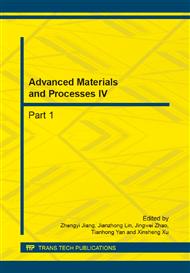[1]
Choudhury, I. a., and M. a. El-Baradie. Surface Roughness Prediction in the Turning of Highstrength Steel by Factorial Design of Experiments., Journal of Materials Processing Technology 67. 1-3 (1997): 55-61.
DOI: 10.1016/s0924-0136(96)02818-x
Google Scholar
[2]
Dimla, Snr Dimla E. Application of Perceptron Neural Networks to Tool-state Classification in a Metal-turning Operation., Engineering Applications of Artificial Intelligence 12. 4 (1999): 471-77.
DOI: 10.1016/s0952-1976(99)00015-9
Google Scholar
[3]
Benardos, P. g, and G. c Vosniakos. Prediction of Surface Roughness in CNC Face Milling Using Neural Networks and Taguchi's Design of Experiments., Robotics and Computer-Integrated Manufacturing 18. 5-6 (2002): 343-354.
DOI: 10.1016/s0736-5845(02)00005-4
Google Scholar
[4]
Lin, W. s., B. y. Lee, and C. l. Wu. Modeling the Surface Roughness and Cutting Force for Turning., Journal of Materials Processing Technology 108. 3 (2001): 286-293.
DOI: 10.1016/s0924-0136(00)00835-9
Google Scholar
[5]
Goonatilake, Suran, and Sukhdev Khebbal. Intelligent Hybrid Systems. Chichester: Wiley, (1995).
Google Scholar
[6]
Mok, S. l., C. k. Kwong, and W. s. Lau. A Hybrid Neural Network and Genetic Algorithm Approach to the Determination of Initial Process Parameters for Injection Moulding., The International Journal of Advanced Manufacturing Technology 18. 6 (2001).
DOI: 10.1007/s001700170050
Google Scholar
[7]
Wang, Kesheng, Hirpa L. Gelgele, Yi Wang, Qingfeng Yuan, and Minglung Fang. A Hybrid Intelligent Method for Modelling the EDM Process., International Journal of Machine Tools and Manufacture 43. 10 (2003): 995-999.
DOI: 10.1016/s0890-6955(03)00102-0
Google Scholar
[8]
Tansel, I. n., B. Ozcelik, W. y. Bao, P. Chen, D. Rincon, S. y. Yang, and A. Yenilmez. Selection of Optimal Cutting Conditions by Using GONNS., International Journal of Machine Tools and Manufacture 46. 1 (2006): 26-35.
DOI: 10.1016/j.ijmachtools.2005.04.012
Google Scholar
[9]
Ozcelik, Babur, Hasan Oktem, and Hasan Kurtaran. Optimum Surface Roughness in End Milling Inconel 718 by Coupling Neural Network Model and Genetic Algorithm., The International Journal of Advanced Manufacturing Technology 27. 3-4 (2005): 234-241.
DOI: 10.1007/s00170-004-2175-7
Google Scholar
[10]
Liu, Wei, Xiuyan Zheng, Shuangjun Liu, and Zhenyuan Jia. A Roughness Measurement Method Based On Genetic Algorithm And Neural Network For Microheterogeneous Surface In Deep-Hole Parts., Journal of Circuits, Systems and Computers 21. 01 (2012).
DOI: 10.1142/s0218126612500053
Google Scholar
[11]
Mukherjee, Indrajit, and Srikanta Routroy. Comparing the Performance of Neural Networks Developed by Using Levenberg-Marquardt and Quasi-Newton with the Gradient Descent Algorithm for Modelling a Multiple Response Grinding Process., Expert Systems with Applications 39. 3 (2012).
DOI: 10.1016/j.eswa.2011.08.087
Google Scholar
[12]
Nalbant, Muammer, Hasan Gökkaya, Ihsan Toktaş, and Gökhan Sur. The Experimental Investigation of the Effects of Uncoated, PVD- and CVD-coated Cemented Carbide Inserts and Cutting Parameters on Surface Roughness in CNC Turning and Its Prediction Using Artificial Neural Networks., Robotics and Computer-Integrated Manufacturing 25. 1 (2009).
DOI: 10.1016/j.rcim.2007.11.004
Google Scholar
[13]
Dombaycı, Ömer Altan, and Mustafa Gölcü. Daily Means Ambient Temperature Prediction Using Artificial Neural Network Method: A Case Study of Turkey., Renewable Energy 34. 4 (2009): 11581161.
DOI: 10.1016/j.renene.2008.07.007
Google Scholar
[14]
Hao, Wangshen, Xunsheng Zhu, Xifeng Li, and Gelvis Turyagyenda. Prediction of Cutting Force for Self-propelled Rotary Tool Using Artificial Neural Networks., Journal of Materials Processing Technology 180. 1-3 (2006): 23-29.
DOI: 10.1016/j.jmatprotec.2006.04.123
Google Scholar


